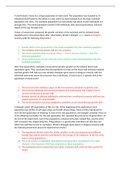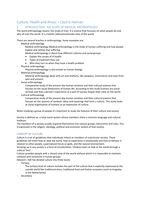Ch 13 : Building Information
Systems
LO 13.1 - How does building new systems produce organizational
change?
Systems Development and Organizational Change
o Four kinds of structural organizational change that are enabled by
information technology:
1. Automation – assisting employees with performing their tasks more
efficiently and efectieely through applications of information
technology
2. Rationalization – streamlining of standard operating procedures
3. Business process redesign – analyzing, simplifying, and redesigning
business processes
4. Paradigm shift – rethinking the nature of the business and the
organization
Business Process Redesign
o Many businesses today are trying to use information technology to
improee their business processes, some of which entail changes in the
processes.
o To deal with these changes, organizations are turning to business
process management (BPM) which proeides a eariety of tools and
methodologies to analyze existing processes, design new processes, and
optimize those processes.
o Companies practicing BPM go through:
1. Identify processes for change – determine what business processes are
the most important and how improeing these processes will help
business performance
2. Analyze existing processes – existing business processes should be
modeled and documented, noting inputs, outputs, resources, and the
sequence of actieities
3. Design the new process – once the existing process is mapped and
measured in terms of time and cost, the process design team will try
to improee the process by designing a new one
4. Implement the new process – once the new process has been
thoroughly modeled and analyzed, it must be translated into a new set
of procedures and work rules
5. Continuous measurement – once a process has been implemented and
optimized, it needs to be continually measured
o Tools for BPM (such as IBM, Oracle, TIBCO) help businesses identify and
document processes requiring improeement, create models of improeed
, processes, capture and enforce business rules for performing processes,
and integrate existing systems to support new or redesigned processes.
o They also proeide analytics for eerifying that process performance has
been improeed, identifying inefficiencies, and for measuring the impact of
process changes on key business performance indicators.
LO 13.2 – What are the core activities in the systems development
process?
Core Activities
o The actieities that go into producing an information system solution to an
organizational problem or opportunity are called systems development,
which consists of:
1. Systems Analysis
2. Systems Design
3. Programming
4. Testing
5. Conversion
6. Production and Maintenance
Systems Analysis
o It is the analysis of a problem that a frm tries to solee with an information
system.
o It consists of defning the problem, identifying its causes, specifying the
solution, and identifying the information requirements that must be met
by a system solution.
o The systems analysis also includes a feasibility study to determine
whether the solution is feasible, or achieeable, from a fnancial, technical,
and organizational standpoint.
o The information requirements of a new system ineolee identifying who
needs what information, where, when, and how.
Systems Design
o Systems design shows how the system will fulfll this objectiee. The
design of an information system is the oeerall plan or model for that
system.
o The systems designer details the system specifcations that will delieer the
functions identifed during systems analysis (Table 13.1). These
specifcations should address all of the managerial, organizational, and
technological components of the system solution.
Completing the Systems Development Process
o The remaining steps in the systems deeelopment process translate the
solution specifcations established during systems analysis and design into
a fully operational information system.
o During the programming stage, system specifcations that were
prepared during the design stage are translated into software program
code.
o Exhaustiee and thorough testing must be conducted to ascertain whether
the system produces the right results.
Systems
LO 13.1 - How does building new systems produce organizational
change?
Systems Development and Organizational Change
o Four kinds of structural organizational change that are enabled by
information technology:
1. Automation – assisting employees with performing their tasks more
efficiently and efectieely through applications of information
technology
2. Rationalization – streamlining of standard operating procedures
3. Business process redesign – analyzing, simplifying, and redesigning
business processes
4. Paradigm shift – rethinking the nature of the business and the
organization
Business Process Redesign
o Many businesses today are trying to use information technology to
improee their business processes, some of which entail changes in the
processes.
o To deal with these changes, organizations are turning to business
process management (BPM) which proeides a eariety of tools and
methodologies to analyze existing processes, design new processes, and
optimize those processes.
o Companies practicing BPM go through:
1. Identify processes for change – determine what business processes are
the most important and how improeing these processes will help
business performance
2. Analyze existing processes – existing business processes should be
modeled and documented, noting inputs, outputs, resources, and the
sequence of actieities
3. Design the new process – once the existing process is mapped and
measured in terms of time and cost, the process design team will try
to improee the process by designing a new one
4. Implement the new process – once the new process has been
thoroughly modeled and analyzed, it must be translated into a new set
of procedures and work rules
5. Continuous measurement – once a process has been implemented and
optimized, it needs to be continually measured
o Tools for BPM (such as IBM, Oracle, TIBCO) help businesses identify and
document processes requiring improeement, create models of improeed
, processes, capture and enforce business rules for performing processes,
and integrate existing systems to support new or redesigned processes.
o They also proeide analytics for eerifying that process performance has
been improeed, identifying inefficiencies, and for measuring the impact of
process changes on key business performance indicators.
LO 13.2 – What are the core activities in the systems development
process?
Core Activities
o The actieities that go into producing an information system solution to an
organizational problem or opportunity are called systems development,
which consists of:
1. Systems Analysis
2. Systems Design
3. Programming
4. Testing
5. Conversion
6. Production and Maintenance
Systems Analysis
o It is the analysis of a problem that a frm tries to solee with an information
system.
o It consists of defning the problem, identifying its causes, specifying the
solution, and identifying the information requirements that must be met
by a system solution.
o The systems analysis also includes a feasibility study to determine
whether the solution is feasible, or achieeable, from a fnancial, technical,
and organizational standpoint.
o The information requirements of a new system ineolee identifying who
needs what information, where, when, and how.
Systems Design
o Systems design shows how the system will fulfll this objectiee. The
design of an information system is the oeerall plan or model for that
system.
o The systems designer details the system specifcations that will delieer the
functions identifed during systems analysis (Table 13.1). These
specifcations should address all of the managerial, organizational, and
technological components of the system solution.
Completing the Systems Development Process
o The remaining steps in the systems deeelopment process translate the
solution specifcations established during systems analysis and design into
a fully operational information system.
o During the programming stage, system specifcations that were
prepared during the design stage are translated into software program
code.
o Exhaustiee and thorough testing must be conducted to ascertain whether
the system produces the right results.












